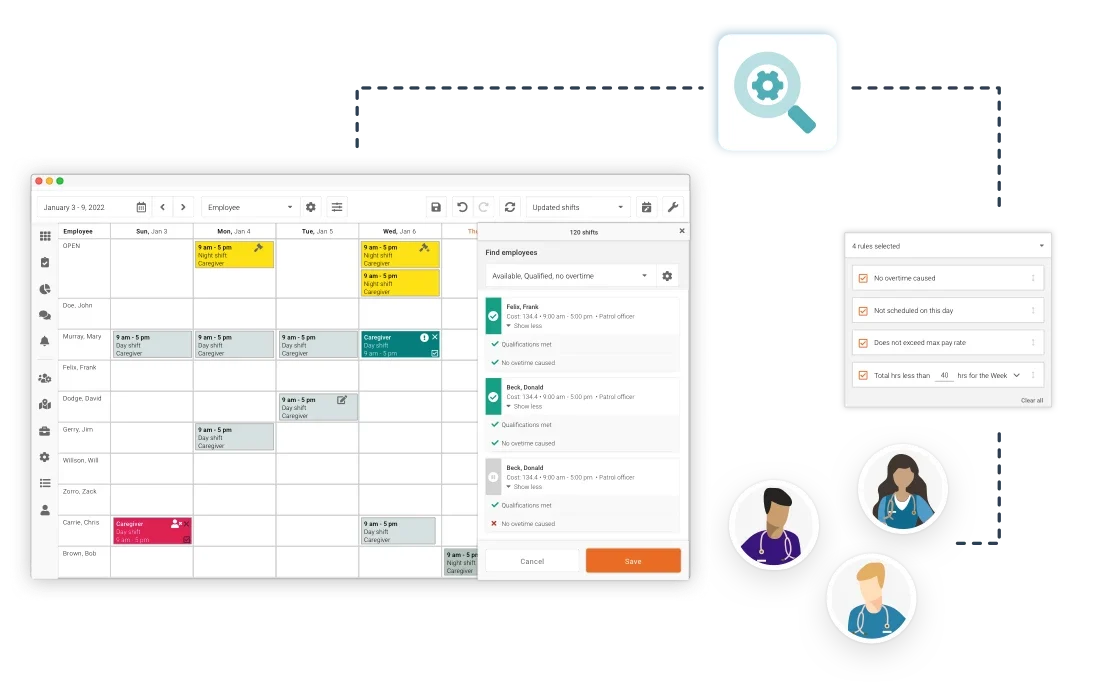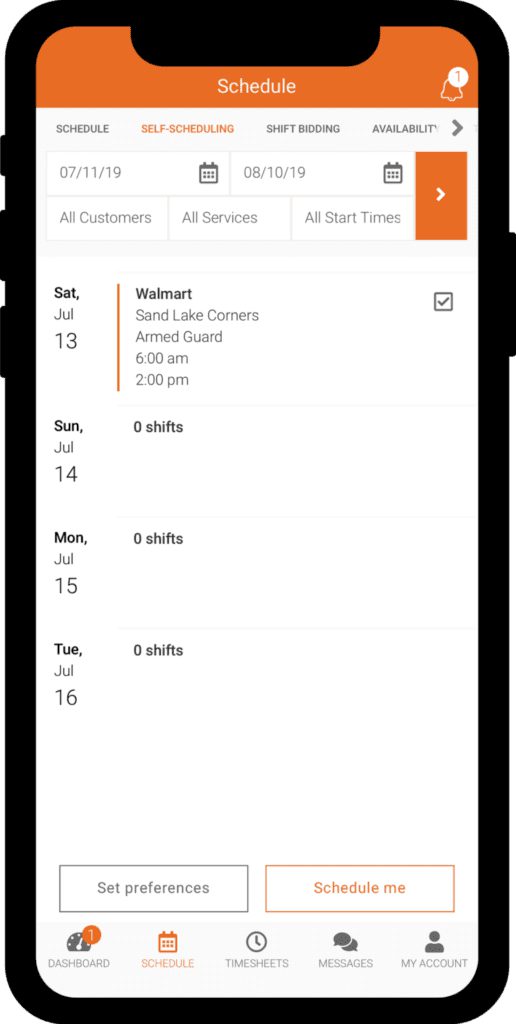Chaotic and shift work schedules are two phrases you don’t want to see together. The schedule creation process should be as easy as possible! If you’re still using excel spreadsheets or paper time sheets as work schedules then you need to keep reading.
What is a shift work schedule?
The term “shift work” usually refers to work schedules that fall outside the hours of 7 am-6 pm. It can be early morning, evening, or night shifts as well as fixed or rotating schedules. According to the Bureau of Labor Statistics, 16% of employers are on shift work schedules. Schedules are created in blocks for full days so there is always an available employee 24/7.

However, companies that offer flexible work options to their employees will see improvements in employee morale and loyalty to the company. Flexible schedules are a great way to allow employees more control over their work-life balance.
What are the benefits of an effective shift work schedule?
A shift work schedule is an integral part of any business that operates on shift work. It means you are scheduling employees in set time blocks throughout a week or month. It allows someone to be available 24/7. An effective shift work schedule is hugely beneficial to businesses.
It can:
- Reduce labor costs – an effective shift work schedule will reduce overtime, avoid overstaffing and ensure that all shifts are optimised for efficiency and profitability.
- Reduce employee turnover – believe it or not, employees place a lot of value on their shift schedule when it comes to job hunting/loyalty. If they are consistently given chaotic schedules, they may look elsewhere!
- Improve employee morale – similar to the point above, employees are happy when their schedule optimised well. Morale improves, meaning reduced absenteeism, and even higher productivity…
- Increase productivity – when you have the right people in the right place at the right time, things get done efficiently!
- Save your company time and money – when all of these things come together, your bottom line improves!
However, creating said effective shift work schedule isn’t as easy as it seems. It can be challenging to set up and maintain if you don’t have the right tools in place.
Impact of chaotic shift work schedules
INCORRECT STAFFING LEVELS:
A chaotic schedule means you may find it difficult to get staffing levels correct. This may be over-scheduling employees where you end up paying more in labor costs than necessary or under-scheduling where you have too few employees to get the job done efficiently. This can actually have a really negative impact on your workers as they are left feeling stressed and burned out.
The liklihood of this increases when you’re dealing with fixed shifts, split shifts, part time and/or full time employees and 12-hour shifts. All of these are common in shift work.
HIGH EMPLOYEE TURNOVER:
Companies that operate using shift work can see high turnover regardless of the state of the schedules. In fact, the service industry has a turnover rate of 12.5% in the US. When you bring inefficient and messy schedules, this number is guaranteed to increase. Employees will eventually get tired of continuous bad schedules and look for work elsewhere which increases your turnover rate.
What does a high turnover rate cost? A lot of money. Your company will have to spend time and money on hiring and training replacements. As well as that, the remaining employees may experience low morale as they are expected to pick up the slack.
WASTED OVERTIME EXPENSES:
When your shift work schedules are disorganized, management struggles to accurately match staffing levels to demand. When this happens, overtime is likely to occur as the demand for workers increases. As you probably know, paying employees overtime rates can be very costly to your business.
This may go unnoticed at the start but when this is an ongoing issue it will eventually impact your bottom line. The worst thing about this is that it could have all been avoided if the schedule was created properly using effective tools!
DECREASE IN EMPLOYEE MORALE:

This has a massive impact on a person’s mental state and physical health also. Unhappy employees are less productive as they don’t have the same motivation to do good work. Whereas, when employees are coming to work with adequate rest times between shifts and when they are not overworked, they will do better work and be more productive.
What to consider when creating shift work schedules
SHIFT LENGTH:
How long are your shifts? Depending on your business they may be long shifts of 12 hours or 24 hours to give employees longer time off in between. For example, some shift work involves overnight shifts such as in the home health care industry.
When operating with long shifts you must take into consideration the productivity levels of employees, overtime costs, and health and safety concerns having employees working that long. The number of hours in a shift is not something to overlook.
SHIFT PATTERN:
What shift pattern is required for your business? What allows employees adequate time off and rest periods? This can look like every weekend off, a day off after every certain number of days worked or a break between every work day.
Maybe you use rotating shift schedules? As usual, this will obviously differ depending on what your business needs are.
QUALIFIED WORKERS:
Some industries require workers to have certain qualifications for specific jobs. For example, healthcare professionals or security professionals. This means you can’t just schedule employees at random, you must have a system in place whereby only qualified workers will be assigned a shift. (Psst, Celyix does this for you in our employee scheduling platform).
OVERTIME:

However, don’t underestimate overtime, it can be extremely costly to an organization. It can not only negatively impact your bottom line but it can also have harmful effects on your staff.
How can you combat chaotic scheduling?
1. Automation:
Automating your scheduling process is key to a great shift work schedule. Not only does it reduce the possibility of human error it also can save you up to 95% of your regular scheduling time! Celayix allows you to build templates that speed up your scheduling process greatly. Our shift templates feature means you can take any number of shifts and save them for reuse in your future schedules.
Rather than starting a schedule from scratch, you can use shift templates. You can apply a template with one click and your schedule gets filled with all your required shifts. Once your schedule is in place you can easily edit shifts to meet your needs.
Create your templates with pre-assigned employees and if you need to swap someone out you can use our feature called “Find a Replacement”. Automating the shift creation process saves you so much trouble!
2. Time off
It is normal that workers may be expected to work outside their regular hours. This usually happens when there is an upcoming deadline that needs more resources or if there are labor shortages.
However, with shift work you need to ensure employees are getting appropriate time off between shifts. As an employer, there is a duty of care to ensure your employees are physically and mentally stable for work. Giving adequate time off for rest is one way you can do this.
3. Flexibility:

- Self-Scheduling: This is where you can create the open shifts you need and your workers can pick them up on a first come, first-served basis.
- Shift-Bidding: This is similar to self-scheduling but your workers will bid on your open shifts. It is then up to the discretion of the scheduler to approve or deny the request.
Paying attention to your employee preferences and giving them these options is extremely valuable when it comes to shift workers.
4. Choose the correct employee
Your employees will have different qualifications, experiences, and competencies. When you use software like Celayix the employees on the platform will have these details saved which allow schedulers to always choose the right employees needed for a certain job. Assign employees to shifts based on your business rules.
For instance, you can create rules around overtime, and union rules. Age restrictions and qualifications.
5. Time and Attendance Tracking:
Time and attendance tracking is another important aspect of shift work schedules. As well as creating schedules you need to ensure employees are starting and ending their shifts on time. In 24-7 industries it can be hard to monitor this.
If you’re not there in person, how you can you tell if employees aren’t leaving early or asking one of their colleagues to clock them in on time? (Also known as time-theft).
Celayix time and attendance platform has powerful built-in features such as geofencing which ensure your team is on-site when they say they are. This gives you peace of mind. It also captures precise attendance data for accurate payroll, billing and compliance. Our software also means you have a method of real-time communication with your employees through in-app messaging on the Celayix mobile app.
The best way to avoid chaotic schedules is to implement employee scheduling software like Celayix. We aren’t just saying it! Employee scheduling software helps you to have control over your workforce management. Using software automates the scheduling process and as a result, reduces the number of errors that causes a chaotic schedule. It ensures your staffing levels are correct every time and makes it easy to track employees’ activities and attendance.
Do you want to start creating efficient & effective shift work schedules? You need to speak to a Celayix Solutions Advisor. Schedule your free, live demo here




